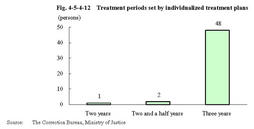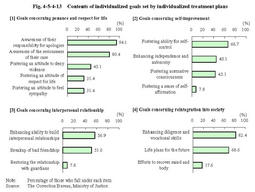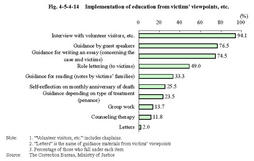| Previous Next Index Image Index Year Selection | |
|
|
2 Treatment at prisons (1) Attribution of prison survey object person Among278object person,an analysis based on data by the Correction Bureau,Ministry of Justice was made for51juvenile inmates whose sentence was determined before March31,2004(hereinafter referred to as"prison survey object person").The analysis was made on what kind of treatment plans were made and implemented at prisons as of February1,2005.The following are the results of the analysis.All of these prison survey object person were males accommodated in juvenile prisons.
Table4-5-4-10 shows prison survey object person by type of offenses and trial result. Table4-5-4-10 Prison survey object person by type of offenses and trial result Table4-5-4-11 shows prison survey object person by type of offenses and classification type of offenses.There were no Family Type juvenile offenders.40(78.4%)of the prison survey object person were Group Type juvenile offenders who committed injury resulting in death. Table4-5-4-11 Prison survey object person by type of offenses and classification type of offenses (2) Contents of individualized treatment plans The treatment for juvenile inmates based on individualized treatment plans is provided for the period until they become20years of age.The treatment continues for around three years for those who will become20in less than three years after admission.For those discharged before the above-mentioned period,the treatment ends at the time of discharge. Fig.4-5-4-12 shows treatment periods set by individualized treatment plans.
Three-year-long treatment period was set for48juveniles(94.1%). Fig.4-5-4-12 Treatment periods set by individualized treatment plans Fig.4-5-4-13 shows the contents of individualized goals set by individualized treatment plans.Fig.4-5-4-13 Contents of individualized goals set by individualized treatment plans (3) Implementation of treatment Among51prison survey object person,only three were granted parole by February1,2005,and the other48were still in prisons.Therefore,it should be noted that the following treatment was still underway for most of them.
It is considered especially important for juvenile inmates who committed serious juvenile offenses to attain individualized education goals,such as developing the awareness of the seriousness of their case and their responsibility to offer apologies to their victims. Fig.4-5-4-14 shows implementation of education from victims'viewpoints,etc. Lectures by crime victims or bereaved families were given to28juveniles(54.9%)out of51prison survey object person.Furthermore,personal interviews by individual assigned instructors and guidance for writing a diary,etc.were implemented. Fig.4-5-4-14 Implementation of education from victims'viewpoints,etc. Fig.4-5-4-15 shows implementation of approaches to guardians.Approaches through guardians'meetings were implemented for21juveniles(41.2%).Furthermore,interviews with guardians were implemented for22juveniles(43.1%)as personal approaches to guardians. Fig.4-5-4-15 Implementation of approaches to guardians In treatment processes,most juveniles have maintained desirable conditions since their entry.However,there were juveniles who showed their willingness to participate in vocational training but would not open up their mind to staff officials and were difficult to understand,and juveniles who led a decent life but were suspected of not having accepted guidance by staff officials earnestly.The following are major examples of juveniles who had significant problems in their life.(i) A case of a juvenile who was apt to focus on maintaining relationships with his peers(a Group Type male) A case of injury resulting in death where a juvenile used violence in a group on the victim,causing death,toward whom he had long held bad feelings
He was restless after entering the institution,receiving punishment several times due to illegal transfer of goods and violence on himself,and could not face his own problems.He held strong dependence on and hatred toward his parents,and showed significant problems also in other interpersonal relationships,focusing too much on maintaining relationships with others. Guidance for writing essays by instructors and interview guidance by volunteer visitors were implemented continuously for this juvenile.Emotional education courses on music and calligraphy were also conducted by visiting lecturers.Furthermore,he was placed in a vocational training course(maintenance of automobiles)and was encouraged to make efforts to obtain a license that would give him confidence for his future vocational career. (ii) A case of a juvenile who had strong antisocial sense of value(a Group Type male) A case of injury resulting in death where a juvenile struck the victim in the head with a metal bat,causing death,triggered by trouble during reckless driving
Even after entering the institution,he took on lazy behaviors,easily affected by his surrounding atmosphere,and was often investigated about troubles that his thoughtless behaviors caused among inmates.He continued to lead a dull life for some time.Although he was cowardly,he had a strong tendency to worry about how surrounding people think of him and show his force by bluffing his way. Counseling by a psychologist officer was implemented regularly for the juvenile,and he was also made to participate in group work designed for life-threatening crime offenders.As a result,he came to have an attitude of following the rules in life without being influenced by his surrounding circumstances. (iii) A case of a juvenile who was apt to distort reality selfishly and repeat failures(a Group Type male) A case of injury resulting in death where a juvenile used violence in a group on the victim,causing death as a lynching,because he had refused to join the hot rodders
From right after entering the institution,he was moody and could not continue working on tasks.He lacked in consideration towards the surrounding inmates and could not fit in well with them due to his savage tongue.He evaluated himself positively,but was apt to distort reality in a selfish way.He often made careless mistakes,easily swayed by emotions. Counseling by a psychologist officer has been implemented regularly for the juvenile,and he has gradually come to show an attitude to face reality objectively. As mentioned above,the level of heinousness of cases does not always correspond to treatment progress in prisons.Various problems in juveniles'attributes seem to cause them to have a problematic life style.All those who have significant problems in life style have still been in prisons,and various approaches have continued to be made in order to solve their problems. |





